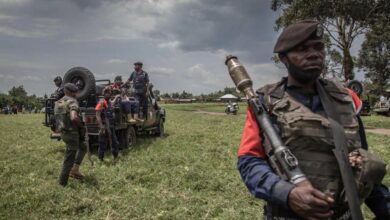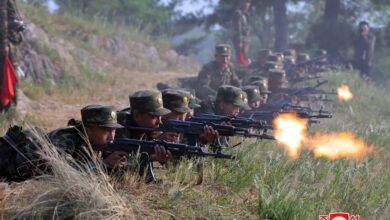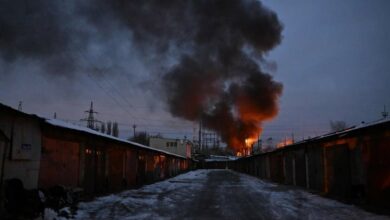JUBA, South Sudan – London-based Conflict Armament Research released a report on Thursday accusing the Ugandan government of diverting European-procured weapons into war-torn South Sudan, which has helped to fuel the nearly five-year conflict.
“Confirming longstanding allegations, CAR field researchers documented ammunition in South Sudan, and with allied forces in neighboring Sudan, that three E.U. states supplied to Uganda in 2014 and 2015,” the report said.
The 101-page report says in one case, a network of U.S. and Ugandan companies controlled by British, Israeli, Uganda, and U.S. nationals – with companies registered in Uganda and the U.S. – procured at least one L-39 trainer/ground attack plane from the United States and an Austrian-made Diamond DA42 surveillance aircraft.
The Diamond DA42 entered service with the Sudan People’s Liberation Army in 2015 and the L-39 in 2016.
CAR deployed researchers in every region in South Sudan between May 2014 and June 2017, documenting weapon and ammunition holdings of armed groups including the SPLA and SPLA-in Opposition (SPLA-IO), the armed wing of Riek Machar’s political movement.
The forensic report is the result of a four-year investigation and was released after South Sudan’ rival foes signed a peace deal in September, ending the nearly five-year conflict which has killed more than 383,000 people.
On July 13 this year, the United Nations Security Council imposed a new arms embargo on South Sudan, but the ammunition documented by CAR entered South Sudan much earlier. The E.U. has embargoed weapons sales to Sudan since 1994 and amended it in 2011 to include newly-independent South Sudan.
The findings suggest that neither the original supplier companies, nor the U.S. or Austrian governments were aware the aircraft might be re-transferred to South Sudan.
The re-transfers from Uganda to South Sudan may have breached end-use or non-transfer commitments made to exporters as a prior condition of sale, the report said.
The report further documented 128 weapons ranging from assault rifles, and anti-tank guided weapons to man-portable air defense systems (MANPADS) and main battle tanks, as well as over 200,000 rounds of ammunition and other military materiel used in the conflict across South Sudan.
The CAR report also documented secret shipments of Sudanese and Chinese-manufactured weapons from Sudan to opposition fighters in South Sudan by air and land from 2014 until at least mid-2015.
The bulk of the ammunition – 99 percent, according to CAR’s findings – is Chinese. Some of it was legally transferred to South Sudan in 2014, and some was delivered clandestinely until 2015. The investigation team identified it at sites of major attacks against civilians, including a February 2016 attack at a U.N. base in Malakal.

South Sudan’s military spokesperson, Major General Lul Ruai Koang said South Sudan acquired such armament in order to protect the government against the SPLA-IO.
“We did what was required of us to restock, resupply and defend the territorial integrity and to defend the democratic government from being toppled using illegal means,” Koang told The Defense Post.
The equipment was purchased, “whether it came through Uganda or not, we had a legitimate cost, we had a good reason at a time South Sudan was fighting the rebellion,” Koang said.
The CAR report says since 2014, at least two offshore companies registered in Seychelles had acted as brokers or intermediaries in actual or attempted arms supplies to South Sudan.
A third Seychellois company brokered the export of ammunition from Romania via the Slovak Republic to Uganda in 2015.
Koang said South Sudan is a sovereign state and has the right to enter into contractual deals with any country it wishes for supply of weapons.
The report says Israel stopped supplying weapons to South Sudan in 2013, but China shipped large quantities of weapons and ammunition in 2014, the United Arab Emirates shipped armored personnel carriers in 2014 and Ukraine sent weapons in 2014 and 2016.
“All the countries we were dealing with us stopped. Maybe they did so because they were complying with the international requirement that they should not continue dealing with the South Sudan army because they are at war. But now that the peace agreement is signed, the same partners would be dictated by the same agreement,” Koang said.
Uganda government spokesperson Ofwono Opondo’s did not answer several calls for comment.
“It’s not our role to judge the politics of any given conflict, simply to report facts and evidence from the ground,” Mike Lewis, CAR Head of Regional Operations for the Sahel said.

The CAR report also highlights failed attempts by the SPLA-IO to obtain weaponry from Europe-based arms dealers and a turboprop aircraft from U.S. and Somali businessmen.
SPLA-IO Deputy military spokesperson Colonel Lam Paul Gabriel said the SPLA-IO does not get ammunition from foreign contractors.
“The source of our supply comes from South Sudan’s government, when there are defections of soldiers who come with their guns. And in some cases we capture ammunition from government stores,” he told The Defense Post.
“The procedure of these people [CAR] is that they come and investigate, and when they get empty boxes of ammunition or trays, they take their photographs, but it doesn’t mean that we got it from Khartoum,” Gabriel added.
But Gabriel couldn’t rule out the fact that such trays were found.
“We have the Justice and Equality Movement militias and the Sudan Liberation Army who fight alongside the border and the Sudan government follows them close to the border.”
“It doesn’t mean that getting a tray of ammunition in our stockpile means we imported [it],” he said.
“Our report largely agrees that, since 2015, external resupply to SPLA-IO has been scarce, and battlefield capture their main source of reprovisioning. Nonetheless in the case of Sudanese supplies to SPLA-IO forces up to 2015, the evidence is more than a few empty crates,” CAR’s Lewis said.
“We documented large-scale seizures of SPLA-IO ammunition: in one case a single consignment of over 150,000 intact rounds. We viewed extensive materiel with lateral impact damage consistent with testimonies of airdrops; and ammunition consignments with deliberately effaced markings originally consigned to Sudan’s intelligence service.”
Gabriel said the SPLA-IO has no relationship with Uganda and hasn’t obtained ammunition from the country since Ugandan troops fought alongside Salvo Kiir’s government in 2013.
This post was edited on November 29 to fix a typo attributing equipment to Australia rather than Austria, and to clarify when shipments from various states occurred and ceased.












